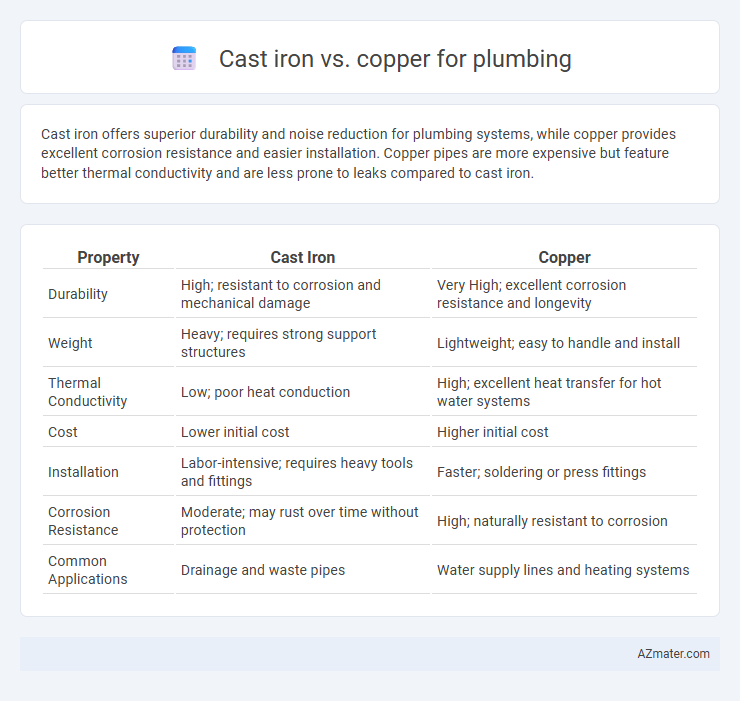Cast iron offers superior durability and noise reduction for plumbing systems, while copper provides excellent corrosion resistance and easier installation. Copper pipes are more expensive but feature better thermal conductivity and are less prone to leaks compared to cast iron.
Table of Comparison
| Property | Cast Iron | Copper |
|---|---|---|
| Durability | High; resistant to corrosion and mechanical damage | Very High; excellent corrosion resistance and longevity |
| Weight | Heavy; requires strong support structures | Lightweight; easy to handle and install |
| Thermal Conductivity | Low; poor heat conduction | High; excellent heat transfer for hot water systems |
| Cost | Lower initial cost | Higher initial cost |
| Installation | Labor-intensive; requires heavy tools and fittings | Faster; soldering or press fittings |
| Corrosion Resistance | Moderate; may rust over time without protection | High; naturally resistant to corrosion |
| Common Applications | Drainage and waste pipes | Water supply lines and heating systems |
Introduction to Cast Iron and Copper Plumbing
Cast iron plumbing offers exceptional durability and noise reduction due to its dense material, making it ideal for drainage systems in commercial and residential buildings. Copper plumbing provides superior corrosion resistance and excellent thermal conductivity, commonly used for water supply lines due to its long-lasting performance and ease of installation. Choosing between cast iron and copper depends on factors such as budget, installation complexity, and the specific needs of the plumbing system.
Material Composition and Properties
Cast iron plumbing pipes consist primarily of iron, carbon, and silicon, offering exceptional durability and resistance to corrosion, especially in underground applications. Copper pipes, composed of copper with trace amounts of other metals like zinc and tin, provide superior thermal conductivity, antimicrobial properties, and flexibility, making them ideal for hot and cold water supply lines. The density and rigidity of cast iron contribute to its sound-dampening qualities, while copper's malleability allows easier installation and resistance to bacterial growth within plumbing systems.
Durability and Longevity Comparison
Cast iron pipes exhibit exceptional durability and longevity, often lasting over 50 years due to their corrosion resistance and strength against external damage. Copper plumbing also offers excellent longevity, typically exceeding 70 years, with a high resistance to bacteria and corrosion under normal water conditions. While both materials provide reliable long-term performance, copper's resistance to corrosion and ease of maintenance often make it a preferred choice for modern plumbing systems.
Installation Process and Flexibility
Cast iron plumbing requires heavy-duty tools and professional expertise for installation due to its weight and rigidity, limiting flexibility in tight spaces. Copper pipes offer easier installation with soldering or compression fittings, allowing for greater adaptability and bending around obstacles without compromising pipe integrity. The flexibility of copper significantly reduces labor time and costs compared to the more labor-intensive cast iron installation process.
Corrosion Resistance and Maintenance
Cast iron offers excellent corrosion resistance due to its protective oxide layer, making it highly durable in plumbing systems with minimal maintenance requirements. Copper also provides superior corrosion resistance, especially in potable water systems, and tends to resist biofilm and bacterial growth, but it may require occasional inspection to prevent pinhole leaks. Both materials ensure longevity in plumbing, but cast iron's robustness suits wastewater applications, while copper's corrosion resistance favors clean water delivery.
Cost Analysis: Cast Iron vs Copper
Cast iron pipes typically cost between $6 to $12 per linear foot, while copper pipes range from $2 to $10 per linear foot, with copper's price fluctuating more due to market demand and raw material costs. Installation expenses for cast iron are higher because of its weight and the requirement for specialized tools, whereas copper's flexibility and ease of handling generally reduce labor costs. Considering long-term durability and maintenance, cast iron offers corrosion resistance and sound dampening benefits, but copper provides superior longevity and fewer leak risks, impacting overall lifetime costs.
Environmental Impact and Sustainability
Cast iron plumbing offers superior durability and recyclability, with approximately 95% of scrap cast iron being reused, reducing landfill waste and lowering carbon emissions in production. Copper, while highly recyclable and antimicrobial, requires significant energy for extraction and refining, contributing to a larger carbon footprint compared to cast iron. Choosing cast iron can enhance environmental sustainability by promoting longer service life and efficient material reuse, whereas copper's value lies in its high recyclability and resistance to corrosion.
Noise Reduction and Water Flow
Cast iron plumbing pipes excel in noise reduction due to their dense, solid structure, which effectively dampens water flow sounds and reduces vibration noise compared to copper pipes. Copper pipes provide smoother internal surfaces that promote better water flow, minimizing resistance and potential pressure drops. While copper offers superior flow efficiency, cast iron remains the preferred choice in applications where noise control is a priority.
Common Applications in Residential and Commercial Buildings
Cast iron pipes are commonly used in residential and commercial buildings for drainage, waste, and vent systems due to their durability and noise-reducing properties. Copper piping is preferred for water supply lines because of its corrosion resistance, longevity, and ability to handle high temperatures and pressures. Both materials serve essential roles, with cast iron often found in sewer and waste systems and copper dominating potable water distribution.
Choosing the Right Plumbing Material for Your Project
Cast iron offers superior durability and excellent noise reduction, making it ideal for drainage and sewer systems in commercial and residential projects. Copper provides high corrosion resistance and antimicrobial properties, suitable for potable water lines where longevity and water quality are priorities. Selecting between cast iron and copper depends on factors such as budget, application type, and environmental conditions influencing plumbing system performance and lifespan.

Infographic: Cast iron vs Copper for Plumbing
 azmater.com
azmater.com